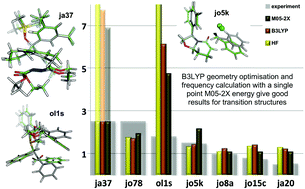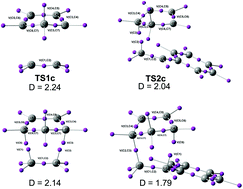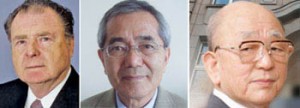This month sees the following articles in OBC that are in the top ten most accessed:-
Chiral BINOL-derived phosphoric acids: privileged Bronsted acid organocatalysts for C-C bond formation reactions
Alexandru Zamfir, Sebastian Schenker, Matthias Freund and Svetlana B. Tsogoeva
Org. Biomol. Chem., 2010, Advance Article, DOI: 10.1039/C0OB00209G , Perspective
In water, on water, and by water: mimicking nature’s aldolases with organocatalysis and water
Nobuyuki Mase and Carlos F. Barbas, III
Org. Biomol. Chem., 2010, 8, 4043-4050, DOI: 10.1039/C004970K , Perspective
Strain-promoted double-click reaction for chemical modification of azido-biomolecules
Isao Kii, Akira Shiraishi, Toshiyuki Hiramatsu, Takeshi Matsushita, Hidehiro Uekusa, Suguru Yoshida, Makoto Yamamoto, Akira Kudo, Masatoshi Hagiwara and Takamitsu Hosoya
Org. Biomol. Chem., 2010, 8, 4051-4055, DOI: 10.1039/C0OB00003E , Communication
Multicolor fluorescent switches in gel systems controlled by alkoxyl chain and solvent
Yue Xu, Pengchong Xue, Defang Xu, Xiaofei Zhang, Xingliang Liu, Huipeng Zhou, Junhui Jia, Xinchun Yang, Fengyong Wang and Ran Lu
Org. Biomol. Chem., 2010, 8, 4289-4296, DOI: 10.1039/C0OB00091D , Paper
High-throughput synthesis of azide libraries suitable for direct “click” chemistry and in situ screening
Rajavel Srinivasan, Lay Pheng Tan, Hao Wu, Peng-Yu Yang, Karunakaran A. Kalesh and Shao Q. Yao
Org. Biomol. Chem., 2009, 7, 1821-1828, DOI: 10.1039/B902338K , Paper
Stereoselective synthesis of the bicyclic guanidine alkaloid (+)-monanchorin
Ahmed M. Zaed and Andrew Sutherland
Org. Biomol. Chem., 2010, 8, 4394-4399, DOI: 10.1039/C0OB00219D , Paper
Selectivity enhancement in functionalization of C-H bonds: A review
Georgiy B. Shul’pin
Org. Biomol. Chem., 2010, 8, 4217-4228, DOI: 10.1039/C004223D , Perspective
Picolylamine as an organocatalyst template for highly diastereo- and enantioselective aqueous aldol reactions
Thomas C. Nugent, M. Naveed Umar and Ahtaram Bibi
Org. Biomol. Chem., 2010, 8, 4085-4089, DOI: 10.1039/C0OB00049C , Paper
Four-fold click reactions: Generation of tetrahedral methane- and adamantane-based building blocks for higher-order molecular assemblies
Oliver Plietzsch, Christine Inge Schilling, Mariyan Tolev, Martin Nieger, Clemens Richert, Thierry Muller and Stefan Bräse
Org. Biomol. Chem., 2009, 7, 4734-4743, DOI: 10.1039/B912189G , Paper
Recent advances in transition metal-catalyzed N-atom transfer reactions of azides
Tom G. Driver
Org. Biomol. Chem., 2010, 8, 3831-3846, DOI: 10.1039/C005219C , Perspective
Why not take a look at the articles today and blog your thoughts and comments below.
Fancy submitting an article to OBC? Then why not submit to us today or alternatively email us your suggestions.
Comments Off on Top ten most accessed articles in September











 Svetlana B Tsogoeva and colleagues at University of Erlagen-Nuremberg review the recent advances on the most successful C-C formation reactions using chiral BINOL phosphates as Bronsted acid catalysts.
Svetlana B Tsogoeva and colleagues at University of Erlagen-Nuremberg review the recent advances on the most successful C-C formation reactions using chiral BINOL phosphates as Bronsted acid catalysts. The manuscript reports an analysis of the performance of different density functionals in computational organic chemistry. The paper is based on a very large number of calculations and provides significant conclusions that have immediate application. The referees said that the manuscript stands out and that is why it is a HOT article.
The manuscript reports an analysis of the performance of different density functionals in computational organic chemistry. The paper is based on a very large number of calculations and provides significant conclusions that have immediate application. The referees said that the manuscript stands out and that is why it is a HOT article.
 Xianzhang Bu and colleagues at Sun Yat-Sen University in China have ‘unexpectedly’ discovered new fluorescent trans-dihydrofluoren-3-ones from one pot reactions of benzaldehydes and acetylacetone.
Xianzhang Bu and colleagues at Sun Yat-Sen University in China have ‘unexpectedly’ discovered new fluorescent trans-dihydrofluoren-3-ones from one pot reactions of benzaldehydes and acetylacetone.